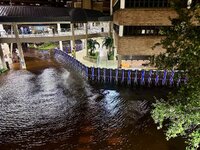Pelotoner2
Structural
There are companies providing temporary flood fences around structures to keep rising water out during a storm. These are only for rising water and not for wave action. We have seen these successfully deployed on the news in FL after Hurricane Helene, and have just received s/s shop drawings for one such site. I am questioning the calculations.
See attached. The flood fence is effectively continuous equal leg braces with struts at some spacing (braces and struts are red in the pdf). The issue I have is using the water weight above the horizontal leg to resist the overturning of the brace. In the calcs we received, the anchor tension force required is zero, though they still provided an anchor.
It seems like the rotation would displace the water above the brace, whereby the system rotates. What am I missing?
See attached. The flood fence is effectively continuous equal leg braces with struts at some spacing (braces and struts are red in the pdf). The issue I have is using the water weight above the horizontal leg to resist the overturning of the brace. In the calcs we received, the anchor tension force required is zero, though they still provided an anchor.
It seems like the rotation would displace the water above the brace, whereby the system rotates. What am I missing?

